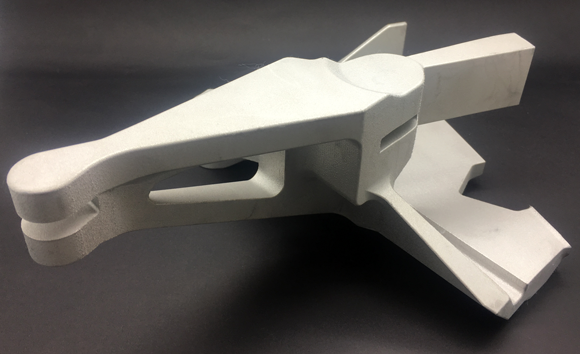GEnx-2B engines power the Boeing 747-8. The PDOS is used on the ground to open and close the fan cowl doors, enabling access to fan compartment for maintenance. The original PDOS brackets were milled from a solid block of metal, which resulted in about 50% of the material being wasted. Using additive manufacturing, GE will be able to reduce waste by about 90% – and also to reduce the bracket’s weight by about 10%, thanks to an improved design made possible by 3D printing.
The component can also be built faster, thanks to the decision to use a cobalt-chrome alloy rather than a traditional nickel-based superalloy. Four brackets will be 3D printed at the same time to maximize efficiency.“We chose this project because it represented several firsts for us,” said Eric Gatlin, General Manager, Additive Integrated Product Team, GE Aviation. “It’s the first program we certified on a Concept Laser machine. It’s also the first project we took from design to production in less than ten months. To ensure the M2 cusing machines were certified to meet the strict requirements for the aerospace industry, collaboration on this programme has been closer than usual with our colleagues at GE Additive. As we continue thinking about the many parts we can design, redesign and manufacture on GE Additive machines, I’m looking forward to putting both our teams and the technology through their paces.”
“It’s been outstanding to watch teams from GE Aviation and GE Additive across the US, Mexico and Germany collaborate,” said Jason Oliver, President and CEO of GE Additive. “In such a short space of time, they have really excelled with the PDOS bracket and achieved a truly groundbreaking success. Seeing the M2 machines produce flight quality hardware, and demonstrating what it is truly capable of, is another great milestone in our own additive journey.”
GE anticipates that the first GEnx-2B engines with the new 3D printed brackets will be shipped in January 2019, which is remarkably quickly – but 3D printing can greatly reduce production time compared to more conventional methods of manufacturing. The brackets are just the latest aircraft components to be switched over to 3D printing, with everything from engines to cabin parts being manufactured with the technology. The aerospace industry has been significantly impacted by additive manufacturing, and while it may be premature to expect an entirely 3D printed plane, it may not be long before we see aircraft with a larger percentage of 3D printed parts than conventionally manufactured ones.
Discuss this and other 3D printing topics at 3DPrintBoard.com or share your thoughts below.
